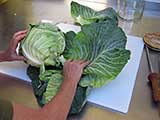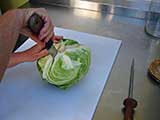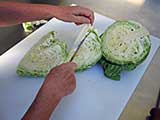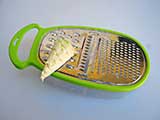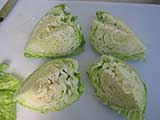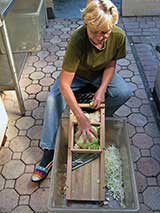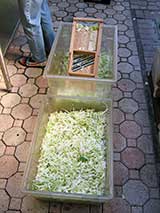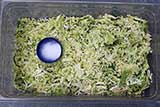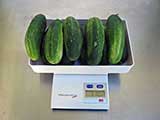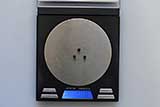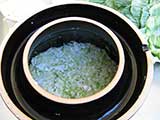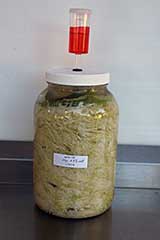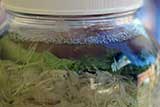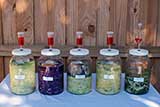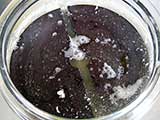Meats and Sausages
Making Sauerkraut
The process of making sauerkraut is based on fermentation, lactic acid bacteria consume sugar and break it into lactic acid, alcohol and carbon dioxide (soda gas).
1. Use fresh and sweet cabbage. Remove the outer leaves and the core. A large cabbage may be halved or quartered.
2. Shred cabbage very thinly, about 2 mm (1/16î) as this will help to release juice. This juice contains nutrients and sugar which are needed for the growth of lactic acid bacteria. When finely cut and packed in a barrel, it will release juice immediately.
3. Shredded cabbage is mixed with salt which immediately draws out juice. If the cabbage has been stored for a few weeks, it is somewhat dry and may release not enough brine to be fully immersed in it. If you don't see brine over the top in two days, prepare and add an extra brine. Add 25 g (4 tsp.) of salt to 950 g (1 quart) of water and pour over the shredded cabbage.
Adding salt not only draws out juice but also creates hostile conditions for spoilage bacteria. Commercial producers add around 2.25%, home producers add usually between 2.25 and 2.50% salt by weight. Adding salt between 2-3% will produce quality sauerkraut. To meet 2.5% salt requirement, 25 g (4 tsp.) of salt is added to 1 kg (2.2 lb) of cabbage.
For consistent results sauerkraut or cucumbers should be weighed. Then the weight of the sauerkraut is multiplied by the desired percentage of salt and the precise amount of salt is calculated. Using cups, spoons or teaspoons can be misleading as for example a cup of table salt weighs differently than a cup of kosher salt. To make the matter worse an American tablespoon/teaspoon is of a different size than the European or Australian one.
4. The salted cabbage is tightly packed into suitable containers such as clay pots, pickle crock, glass jars or food grade plastic pails (3-5 gallons). As the first layer of about 25 mm (one inch) of shredded sauerkraut was placed at the bottom, it was sprinkled with salt, then another layer of shredded cabbage was added and more salt added. This is repeated until the barrel is three quarters full to allow the expansion of the cabbage. You can mix shredded sauerkraut with salt in a large mixing bowl and then place it in a container. If a significant amount of cabbage is shredded, the mixing and packing can be done in stages. Make sure you tamp it down very firmly using your hands or some suitable device, for example a potato masher. Fresh cabbage will start releasing juice during mixing and packing.
5. A clean cloth, a piece of muslin, or two layers of cheese cloth are placed on top of shredded cabbage before adding the weight plate. Many people cover the shredded cabbage with whole cabbage leaves. If the brine gets scummy it is easier to replace cabbage leaves or cloth than to scoop up the scum. The purpose of the weight plate is to keep the shredded cabbage submerged in brine. Often a round wooden board was used on which a rock was usually placed. Brine or water filled plastic bag can be placed on top of the shredded cabbage and will conform to the shape of the container, keeping shredded cabbage below the accumulating liquid. The plastic bag may break and spill out its content into the cabbage. Water will dilute the fermenting brine and may adversely affect the process, so it is wiser to fill the bag with brine. Adding 25 g (4 tsp.) of salt to 950 g (1 quart) of water makes an acceptable brine. The weight keeps the cabbage submerged in liquid and out of contact with direct air. This prevents yeasts from growing on the surface as they need oxygen to multiply. Yeasts can produce slime and even discolor the sauerkraut.
Shredded cabbage should be covered by brine what prevents yeasts and molds from producing white scum.
Freshly packed cabbage displays bright green and white color. The color will start turning to light yellow as the fermentation progresses.
If any white foam accumulates on top of the cabbage it should be scuped away and the weights should be washed and reused. Slime producing yeasts need air to survive so the rest of the sauerkraut is not affected. Always pick up sauerkraut from the top, don't stir the contents of the barrel.
Summary of Critical Issues
Use fresh and sweet cabbage. Cabbage should contain up to 3.5% sugar. The sweeter raw cabbage is the better sauerkraut will be obtained.
Adding less than 2% salt might produce soft or even slimy sauerkraut. Adding less than 1% will produce sauerkraut that would be soft and unacceptable commercially. Adding more than 3.5% salt might inhibit growth of lactic acid bacteria.
The more lactic acid that is produced the more acidic the sauerkraut becomes. There is a limit how much lactic acid can be produced as the increased acidity inhibits bacteria growth. Once the sugar supply is exhausted, lactic acid bacteria stop growing as well.
White scum on the surface of the sauerkraut is due to yeasts and should be removed every few days. There is no reason to discard the sauerkraut.
It is possible to use the brine from the previous sauerkraut fermentation as a starter culture for a new production. This is a common method used in the production of bread or even salami (back slopping), where part of a fermented product is saved for new production. In theory at least, it should produce a new batch with the same characteristics as the old one.
During fermentation glucose (sugar) is converted to about 50% lactic acid, 25% acetic acid and ethyl alcohol, and 25% carbon dioxide.
Keep the fermentation temperature below 80° F (27° C). For best quality sauerkraut maintain a fermentation temperature at around 68° F (20° C).
The process of making sauerkraut and pickled cucumbers is very similar. Both products are made using the same equipment, cucumbers of course are not shredded, although they may be sliced.
Keep the sufficient level of brine to cover sauerkraut.
Fermenting glass jars should be kept in a dark place.

